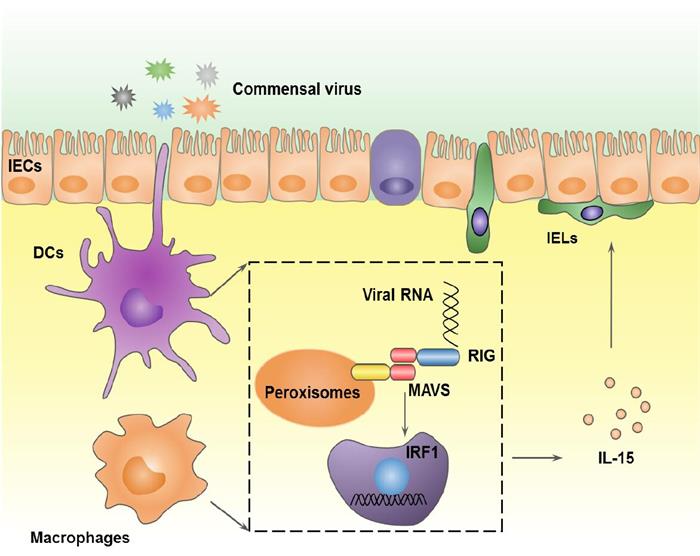Commensal viruses sustain intestinal immune homeostasis
Source:Rongbin Zhou
2019-12-30
The gut harbors a numerous microorganisms including bacteria, fungi and viruses. Much attention has focused on the role of commensal bacteria in the health and diseases, while the contribution of commensal viruses during the process are less known.
On October 21, 2019, Prof. Rongbin Zhou, Prof. Wei Jiang, Prof. Shu Zhu and their group at the University of Science and Technology of China published a research article in Nature Immunology, entitled " Commensal viruses maintain intestinal intraepithelial lymphocytes via noncanonical RIG-I signaling."
The intestinal immune system is the most complex part of host immune system, which is mainly consist of intestinal intraepithelial lymphocytes (IELs), lamina propria lymphocytes (LPLs) and Peyer’s patches (PPs). And, IELs are comprised of multiple immune cell subsets and play a vital role in the homeostasis of intestinal mucosa. To investigate the role of commensal viruses in the immune homeostasis, researchers fed wild-type mice with an antiviral cocktail (AVC) to deplete the commensal viruses and found that commensal viruses depletion attributed to the loss of IELs in the small intestine and colon, while it had no effect on the lymphocytes of other immune organs. Further studies indicated that commensal viruses recognized by antigen-presenting cells (APCs) could induce IL-15 production via RIG-I-MAVS signaling to sustain the IELs homeostasis . Moreover, the recovery of IELs by IL-15 supplementation could ameliorate the susceptibility of colitis in AVC-treated mice.

Collectively, the work revealed a physiological function of commensal viruses in IELs homeostasis, suggesting that commensal viruses might play a crucial role in the development of intestinal inflammatory diseases and colon cancer.
This work was supported by the National Natural Science Foundation of China, the National Key R&D program of China, the Chinese Academy of Sciences, and the Fundamental Research Funds for the Central Universities.
Links: https://www.nature.com/articles/s41590-019-0513-z
On October 21, 2019, Prof. Rongbin Zhou, Prof. Wei Jiang, Prof. Shu Zhu and their group at the University of Science and Technology of China published a research article in Nature Immunology, entitled " Commensal viruses maintain intestinal intraepithelial lymphocytes via noncanonical RIG-I signaling."
The intestinal immune system is the most complex part of host immune system, which is mainly consist of intestinal intraepithelial lymphocytes (IELs), lamina propria lymphocytes (LPLs) and Peyer’s patches (PPs). And, IELs are comprised of multiple immune cell subsets and play a vital role in the homeostasis of intestinal mucosa. To investigate the role of commensal viruses in the immune homeostasis, researchers fed wild-type mice with an antiviral cocktail (AVC) to deplete the commensal viruses and found that commensal viruses depletion attributed to the loss of IELs in the small intestine and colon, while it had no effect on the lymphocytes of other immune organs. Further studies indicated that commensal viruses recognized by antigen-presenting cells (APCs) could induce IL-15 production via RIG-I-MAVS signaling to sustain the IELs homeostasis . Moreover, the recovery of IELs by IL-15 supplementation could ameliorate the susceptibility of colitis in AVC-treated mice.

Collectively, the work revealed a physiological function of commensal viruses in IELs homeostasis, suggesting that commensal viruses might play a crucial role in the development of intestinal inflammatory diseases and colon cancer.
This work was supported by the National Natural Science Foundation of China, the National Key R&D program of China, the Chinese Academy of Sciences, and the Fundamental Research Funds for the Central Universities.
Links: https://www.nature.com/articles/s41590-019-0513-z


